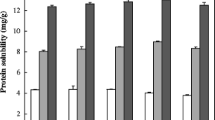Abstract
Reduced-fat sausages were prepared by replacing pork back fat with barley flours of different particle sizes. Three barley flour fractions with different particle size were obtained by passing the ground barley material through a sieve. Fraction 1 and 2 had a higher water absorption index than other fraction and showed higher peak and final viscosities due to higher β-glucan content. Therefore, fraction 1 and 2 were used as a fat replacer in preparation of reduced-fat sausages. Response surface methodology was employed to optimize the formulation of reduced-fat sausage and the effects of fat content and barley flour paste concentration on the textural properties were analyzed simultaneously. Using a regression model, the optimum formulation of reduced-fat sausage was calculated. For fraction 1, calculated levels of fat content and paste concentration were 7.6 and 3.9%, and for fraction 2, levels were 6.7 and 6.9%, respectively.
Similar content being viewed by others
References
Carballo J, Barreto G, Jimenez-Colmenero F. Starch and egg white influence on properties of bologna sausage as related to fat content. J. Food Sci. 60: 673–677 (1995)
Hughes E, Confrades S, Troy DJ. Effects of fat level, oat fibre, and carrageenan on frankfurters formulated with 5, 12, and 30% fat. Meat Sci. 45: 273–281 (1996)
Pietrasik Z, Duda Z. Effect of fat content and soy protein/carrageenan mix on the quality characteristics of comminuted, scalded sausages. Meat Sci. 56: 181–188 (2000)
Yang HS, Choi SG, Jeon JT, Park GB, Joo ST. Texture and sensory properties of low fat pork sausages with added hydrated oatmeal and Tofu as texture-modifying agents. Meat Sci. 75: 283–289 (2007)
Khalil AH. Quality characteristics of low-fat beef patties formulated with modified corn starch and water. Food Chem. 68: 61–68 (2000)
Cofrades S, Guerra MA, Carballo J, Fernandez-Martin F, Jimenez Colmenero F. Plasma protein and soy fiber content effect on bologna sausage properties as influenced by fat level. J. Food Sci. 65: 281–287 (2000)
Hecker KD, Meier ML, Newman RK, Newman WC. Barley β-glucan is effective as a hypocholesterolaemic ingredient in foods. J. Sci. Food Agr. 77: 179–183 (1998)
Yokoyama WH, Hudson CA, Knuckles BE, Chiu MCM, Sayre RN, Turnlund JR, Schneeman BO. Effect of barley β-glucan in durum wheat pasta on human glycemic response. Cereal Chem. 73: 293–296 (1997)
Knuckles BE, Chiu MM. β-Glucan enrichment of barley fractions by air classification and sieving. J. Food Sci. 60: 1070–1074 (1995)
Sundberg B, Tilly AC, Åman P. Enrichment of mixed-linked (1-3), (1-4)-β-d-glucans from a high-fibre barley-milling stream by air classification and stack-sieving. J. Cereal Sci. 21: 205–208 (1995)
Stevenson DG, Jane JL, Inglett GE. Structure and physicochemical properties of starches from sieve fractions of oat flour compared with whole and pin-milled flour. Cereal Chem. 84: 533–539 (2007)
Murphy SC, Gilroy D, Kerry JF, Buckley DJ, Kerry JP. Evaluation of surimi, fat, and water content in a low/no added pork sausage formulation using response surface methodology. Meat Sci. 66: 689–701 (2004).
AACC. Approved Method of the AACC. 10th ed. Methods 44-15A, 46-11A, 08-01, and 30-10. American Association of Cereal Chemists, St. Paul, MN, USA (2000)
AACC. Approved Method of the AACC. 10th ed. Methods 61-02. American Association of Cereal Chemists, St. Paul, MN, USA (2000)
Lee YT, Seog HM, Cho MK. β-Glucan enrichment from pearled barley and milled barley fractions. Korean J. Food Sci. Technol. 29: 888–894 (1997)
Hoseney RC. Principles of Cereal Science and Technology. 2nd ed. American Association of Cereal Chemists, St. Paul, MN, USA. pp. 1–26 (1994)
Yoon SH, Berglund PT, Fastnaught CE. Evaluation of selected barley cultivars and their fractions for β-glucan enrichment and viscosity. Cereal Chem. 72: 187–190 (1995)
Zheng GH, Rossnagel BG, Tyler RT, Bhatty RS. Distribution of β-glucan in the grain of hull-less barley. Cereal Chem. 77: 140–144 (2000)
Kerr WL, Ward CDW, McWatters KH, Resurreccion AVA. Effect of milling and particle size on functionality and physicochemical properties of cowpea flour. Cereal Chem. 77: 213–219 (2000)
Choi HD, Seog HM, Kim SR, Park YK, Lee CH. Effect of β-glucan on gelatinization of barley starch. Korean J. Food Sci. Technol. 35: 545–550 (2003)
Kim SR, Choi HD, Seog HM, Kim SS, Lee YT. Physicochemical characteristics of β-glucan isolated from barely. Korean J. Food Sci. Technol. 31: 1164–1170 (1999)
Rojas JA, Rosell CM, Benedito de Barber C. Pasting properties of different wheat flour-hydrocolloid systems. Food Hydrocolloid. 13: 27–33 (1999)
Song JY, Kim YC, Shin MS. Textural properties and structures of wheat and maize starch-gum mixed gels during storage. Food Sci. Biotechnol. 17: 20–25 (2008)
Lee MH, Baek MH, Cha DS, Park HJ, Lim ST. Freeze-thaw stabilization of sweet potato starch gel by polysaccharide gums. Food Hydrocolloid. 16: 345–352 (2002)
Shand PJ, Texture, water holding, and sensory properties of low-fat pork bologna with normal or waxy starch hull-less barley. J. Food Sci. 65: 101–107 (2000)
Morin LA, Temelli F, Mcmullen L. Physical and sensory characteristics of reduced-fat breakfast sausages formulated with barley β-glucan. J. Food Sci. 67: 2391–2396 (2002)
Aleson-Carbonell L, Fernandez-Lopez J, Perez-Alvarez JA, Kuri V. Functional and sensory effects of fibre-rich ingredients on breakfast fresh sausages manufacture. Food Sci. Technol. Int. 11: 89–97 (2005)
Author information
Authors and Affiliations
Corresponding author
Rights and permissions
About this article
Cite this article
Choi, JW., Kim, SH., Mun, S. et al. Optimizing the replacement of pork fat with fractionated barley flour paste in reduced-fat sausage. Food Sci Biotechnol 20, 687–694 (2011). https://doi.org/10.1007/s10068-011-0097-3
Received:
Revised:
Accepted:
Published:
Issue Date:
DOI: https://doi.org/10.1007/s10068-011-0097-3




